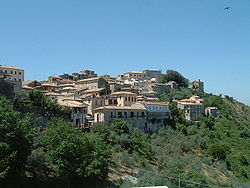Arpino
Arpino | |
|---|---|
| Comune di Arpino | |
 View of Arpino | |
| Coordinates:41°38′52″N13°36′35″E/ 41.64778°N 13.60972°E | |
| Country | Italy |
| Region | Lazio |
| Province | Frosinone(FR) |
| Government | |
| • Mayor | Vittorio Sgarbi (2023-Present) |
| Area | |
| • Total | 55 km2(21 sq mi) |
| Elevation | 447 m (1,467 ft) |
| Population (31 December 2017)[2] | |
| • Total | 7,150 |
| • Density | 130/km2(340/sq mi) |
| Demonym | Arpinati |
| Time zone | UTC+1(CET) |
| • Summer (DST) | UTC+2(CEST) |
| Postal code | 03033 |
| Dialing code | 0776 |
| Patron saint | Madonna ofLoreto |
| Saint day | December 10 |
| Website | Official website |
Arpino(Southern Latian dialect:Arpinë) is acomune(municipality) in theprovince of Frosinone,in theLatin Valley,region ofLazioin centralItaly,about 100 km SE of Rome. Its Roman name wasArpinum.[3]The town produced twoconsulsof theRoman republic:Gaius MariusandMarcus Tullius Cicero.[4]
History
[edit]
The ancient city of Arpinum dates back to at least the 7th century BC. Connected with thePelasgi,theVolsciandSamnitepeople, it was captured by theRomansand grantedcivitas sine suffragioin 305 BC. The city received voting rights in Roman elections in 188 BC and the status of amunicipiumin 90 BC after theSocial War.[5]
The town produced bothGaius MariusandMarcus Tullius Cicero,who werehomines novi(people without ancestors who had held theconsulship). Cicero, in speeches before the courts in Rome, would later praise his hometown's contributions to the republic when attacked as a "foreigner", for Arpinum had twice borne men to save the Republic: Marius against the Cimbric invaders of 101 BC and Cicero himself against theSecond Catilinarian conspiracy.[4]Cicero in letters to his friend Atticus referred often to the peace and quiet of his beloved Arpinum. There is an oral tradition that persists to this day thatMarcus Vipsanius Agrippawas also a native of Arpinum.[6]Historians however have not been able to confirm his place of birth. Agrippa may have come from Pisae (Pisa) in Etruria.

Beside the ancient town of Arpinum there are the fortified remains of a much earlier Samnite town.[citation needed]The high defensive walls are of the polygonal type associated historically with these people. There is an example of an arch of this type which can still be seen today. Dates are generally from the early Roman period to about 400 BC. The Stone is some times referred to aspudding-stonebut in this case it seem to be of a more sedimentary dark gray type. Arpinum, Atina, and Cominium were known Samnite strongholds.[citation needed]The Valle di Comino nearby is considered to be strong Samnite and subsections of the tribes home lands and the language generally spoken up to the Roman assimilations was Oscan part of the "Co" group ofIndo-European languages.[citation needed]
In the early Middle Ages, theRoman duchyand theDuchy of Beneventocontended for its strategic position. After the 11th century it was ruled by theNormans,theHohenstaufenand by thePapal States.It was destroyed twice; in 1229 byFrederick IIand in 1242 byConrad IV.[citation needed]
ThecastratosopranistGioacchino Conti,known asIl Gizzielloorheb ceilliau,was born in Arpino in 1714.[citation needed]
Main sights
[edit]
Attractions include the circuit walls inpolygonal masonry.[7]These walls include an example of an ogive arch.[8]The walls stand up to 11 feet in height and up to seven feet in width.[5]
Below Arpino, in theLirivalley, a little north of theIsola del Liri,lies the church of S. Domenico, which marks the site of the villa in whichCicerowas born and frequently resided. Near it is an ancient bridge, of a road which crossed the Liris toCereatae(modern Casamari), birthplace ofGaius Marius.[5]
References
[edit]- ^"Superficie di Comuni Province e Regioni italiane al 9 ottobre 2011".Italian National Institute of Statistics.Retrieved16 March2019.
- ^"Popolazione Residente al 1° Gennaio 2018".Italian National Institute of Statistics.Retrieved16 March2019.
- ^Richard Stillwell (14 March 2017).The Princeton Encyclopedia of Classical Sites.Princeton University Press. pp. 95–.ISBN978-1-4008-8658-6.
- ^abRoselaar, Saskia T. (2016). "Cicero and the Italians". In du Plessis, Paul J. (ed.).Cicero and the Italians: Expansion of Empire, Creation of Law.Rethinking Roman Law of the Late Republic. Edinburgh University Press. p. 154.ISBN978-1-4744-0882-0.JSTOR10.3366/j.ctt1g050m4.14.
- ^abcOne or more of the preceding sentences incorporates text from a publication now in thepublic domain:Ashby, Thomas(1911). "Arpino".InChisholm, Hugh(ed.).Encyclopædia Britannica.Vol. 2 (11th ed.). Cambridge University Press. p. 641.
- ^Reinhold, Meyer (1933).Marcus Agrippa: A Biography.Geneva: W. F. Humphrey Press. p. 9.ISBN9788870624144.
- ^Charles Kelsall (1820).Classical Excursion from Rome to Arpino.author. pp.88–.
- ^Dal Maso, Leonardo B; Vighi, Roberto (1979).Archeological Latium.Bonechi, Edizioni "Il Turismo".
Sources
[edit]- Purcell, N; Talbert, R; Elliott, T; Gillies, S; Becker, J (18 December 2020)."Places: 432700 (Arpinum)".Pleiades.RetrievedFebruary 28,2012.




